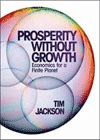Rebound and Backfire Effects from Abatement Actions by UK Households
Overall aims
Do household abatement actions aimed at reducing carbon emissions, such as walking instead of driving short journeys, achieve the reductions predicted? Or are the reductions achieved in practice lower?
Context
Households are expected to play a pivotal role in reducing the UK’s carbon emissions, and the Government is targeting specific household actions to help meet its targets. However, by focusing on discrete actions, the Government risks failing to take account of the ‘Rebound Effect’ – a phenomenon whereby carbon reductions estimated by simple engineering calculations are frequently not realised in practice. For example, replacing short car journeys by walking or cycling reduces consumption of personal transportation fuels. But this frees money that could be spent on, for example, purchasing extra clothes or flying on vacation. Alternatively it may be put into savings. These options all give rise to carbon emissions, and thus the total carbon saved may be less than predicted. Indeed, in some instances, emissions may even increase – this being known as ‘Backfire Effect’.Research questions and methods
The key questions the study addressed were: What is the most likely size of the rebound effect? What are its lowest and highest bounds? How might it be influenced by the way in which the avoided expenditure is re-used? And what steps can be taken to minimise rebound?
We investigate the rebound effect for a set of three abatement actions (reducing internal temperatures by 1oC by means of lowering the thermostat; reducing food purchased by one third by eliminating food waste; and walking or cycling instead of using a car for trips of less than 2 miles). We assume that expenditure avoided due to these actions is either re-spent on other goods and services or is saved (invested). Using a general framework we varied the proportion of avoided expenditure that is re-spent or saved, and also vary the expenditure categories in which the re-spending is carried out.
Estimation of the rebound effect for the abatement actions relies on having information on the GHG intensity of different categories of goods and services; the expenditure elasticities of those goods and services; the GHG intensity of savings; and the savings rate. In this study we make use of two models developed within RESOLVE at the University of Surrey. The first is the Surrey Environmental Lifestyle MApping (SELMA) framework from which we obtain GHG intensities 1992-2004 (Druckman and Jackson 2008; 2009a; 2009b). The second is the Econometric Lifestyle Environmental Scenario Analysis (ELESA) model from which we obtain estimates of income elasticities and GHG emissions for 2008 (Chitnis and Hunt 2009).
Results
We estimate that the rebound effect for the set of three abatement actions is around 34%. This means that only around two-thirds of the predicted (hoped for) reductions in GHG emissions are likely to be achieved in practice. By varying the expenditure categories in which the avoided expenditure is re-spent, we estimate that that in the best case studied rebound may be reduced to 12%, but in extreme cases backfire may occur. If all the avoided expenditure were to be invested in general savings such as through bank deposit, the consequence would be to lower the rebound effect to around 26%.
A more enlightened household intent on achieving the best outcome might put the expenditure avoided into ‘green’ investments. Depending on the carbon intensity of the investment chosen, the rebound may in this case approach zero. Furthermore, if the money were invested in ultra low carbon technology, it is possible, in theory, to achieve negative emissions. This would result in a negative rebound effect. In other words, the overall emissions reductions due to the action would be greater than those estimated without taking account of the rebound effect.
Implications
Our study points to two key strategies to minimise rebound: to encourage households to shift patterns of consumption to lower GHG intensive categories; and to encourage households to take up low carbon investments.
Outputs
Druckman, A, M Chitnis, S Sorrell and T Jackson 2011. Missing carbon reductions? Exploring rebound and backfire effects in UK households. Energy Policy 39: 3572–3581.
Druckman, A., M. Chitnis, S Sorrell and T Jackson 2010. An investigation into the rebound and backfire effects from abatement actions by UK households. RESOLVE Working Paper Series 05-10. Guildford: University of Surrey.
Druckman, A, M Chitnis, S Sorrell and T Jackson 2010. Shifting sands? Exploring rebound and backfire in a changing economy. International Society for Ecological Economics (ISEE) 11th Biennial Conference: ‘Advancing sustainability in a time of crisis’. Oldenburg and Bremen, Germany. 22–25 August 2010.
Druckman, A, M Chitnis, S Sorrell and T Jackson 2010. Missing carbon reductions? Exploring rebound and backfire effects in UK households. The 14th European Roundtable on Sustainable Production and Consumption (ERSCP), Delft, The Netherlands, October 25-29, 2010.





